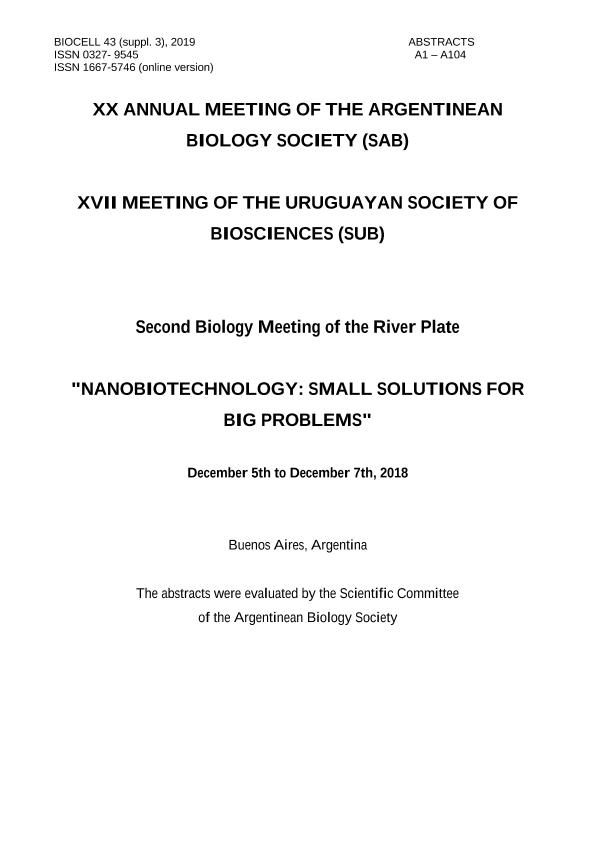Mostrar el registro sencillo del ítem
dc.contributor.author
Gomez, Gabriela Noemi

dc.contributor.author
Acevedo Gomez, Antonella Valeria

dc.contributor.author
Nerli, Bibiana Beatriz

dc.contributor.author
Leiva, Laura Cristina Ana

dc.date.available
2022-10-14T12:38:11Z
dc.date.issued
2019
dc.identifier.citation
Pacu viscera extract obtained by aqueous two-phase system: potential application in recycling waste; XX Annual Meeting of the Argentinean Biology Society (SAB) . VII Meeting of the Uruguayan Society of Biosciences (SUB). Second Biology Meeting Of The River Plate; Buenos Aires; Argentina; 2018; 33-33
dc.identifier.issn
0327-9545
dc.identifier.uri
http://hdl.handle.net/11336/173176
dc.description.abstract
Pacú (Piaractus mesopotamicus) production represents 40% of northeast fish yield. It is of interest to valorize the current disposal of fish processing through the use of viscera waste, source of enzymes such as trypsin. Aqueous two-phase systems (ATPS) have been successfully used for separation and purification of macromolecules because exhibit multiple advantages: good resolution, high yield, low cost and proteins retain their biological activity. The goal of this work was to analyze the partition of pacú pyloric caeca extract in aqueous two-phase PEG-citrate systems. Preparation of crude alkaline extract was made by mechanical and sonic digestion of pyloric caeca. A two-phase system formed by polyethyleneglycol (PEG) 3350 - citrate, pH 8.4, was used and the partition of alkaline proteins of the extract was assayed. Trypsin activity was determined with the substrate a-Nbenzoyl-DL-arginine-p-nitroanilide (BAPNA) and protein content was estimated by the Warburg and Christian method. Partition coefficients (Kp) were calculated by the ratio of enzyme trypsin activity or total protein between phases. The experiments revealed that partition coefficient of trypsin was greater than unity (KpTrip: 2,2), while partition coefficient of total proteins was smaller than one (KpTP: 0,33). This result indicates a tendency for trypsin-like enzymes to concentrate in the top phase (PEG-enriched phase), while proteins were partitioned to the salt-enriched phase (bottom phase). Thus, a high separating capability was verified in the assayed system. On the other hand, X ray plates were treated with the top phase achieving a complete removed of the gelatine layer which covers it, with no interference of PEG. These studies demonstrate the applicability of a simple procedure to obtain a phase enriched with enzymes from pacú viscera extracts and their use in recycling of radiographic plates.
dc.format
application/pdf
dc.language.iso
eng
dc.publisher
Tech Science Press

dc.rights
info:eu-repo/semantics/openAccess
dc.rights.uri
https://creativecommons.org/licenses/by/2.5/ar/
dc.subject
PACU
dc.subject
VISCERAS
dc.subject
WASTE
dc.subject
AQUEOUS TWO-PHASE SYSTEM
dc.subject.classification
Bioprocesamiento Tecnológico, Biocatálisis, Fermentación

dc.subject.classification
Biotecnología Industrial

dc.subject.classification
INGENIERÍAS Y TECNOLOGÍAS

dc.title
Pacu viscera extract obtained by aqueous two-phase system: potential application in recycling waste
dc.type
info:eu-repo/semantics/publishedVersion
dc.type
info:eu-repo/semantics/conferenceObject
dc.type
info:ar-repo/semantics/documento de conferencia
dc.date.updated
2022-03-16T20:29:20Z
dc.identifier.eissn
1667-5746
dc.journal.volume
43
dc.journal.number
Suppl. 3
dc.journal.pagination
33-33
dc.journal.pais
Argentina

dc.journal.ciudad
Buenos Aires
dc.description.fil
Fil: Gomez, Gabriela Noemi. Universidad Nacional del Nordeste. Facultad de Ciencias Exactas Naturales y Agrimensura. Departamento de Bioquímica. Laboratorio de Investigación en Proteínas; Argentina. Consejo Nacional de Investigaciones Científicas y Técnicas. Centro Científico Tecnológico Conicet - Nordeste; Argentina
dc.description.fil
Fil: Acevedo Gomez, Antonella Valeria. Universidad Nacional del Nordeste. Facultad de Ciencias Exactas Naturales y Agrimensura. Departamento de Bioquímica. Laboratorio de Investigación en Proteínas; Argentina. Consejo Nacional de Investigaciones Científicas y Técnicas. Centro Científico Tecnológico Conicet - Nordeste. Instituto de Modelado e Innovación Tecnológica. Universidad Nacional del Nordeste. Facultad de Ciencias Exactas Naturales y Agrimensura. Instituto de Modelado e Innovación Tecnológica; Argentina
dc.description.fil
Fil: Nerli, Bibiana Beatriz. Consejo Nacional de Investigaciones Científicas y Técnicas. Centro Científico Tecnológico Conicet - Rosario. Instituto de Procesos Biotecnológicos y Químicos Rosario. Universidad Nacional de Rosario. Facultad de Ciencias Bioquímicas y Farmacéuticas. Instituto de Procesos Biotecnológicos y Químicos Rosario; Argentina
dc.description.fil
Fil: Leiva, Laura Cristina Ana. Universidad Nacional del Nordeste. Facultad de Ciencias Exactas Naturales y Agrimensura. Departamento de Bioquímica. Laboratorio de Investigación en Proteínas; Argentina
dc.relation.alternativeid
info:eu-repo/semantics/altIdentifier/url/https://www.techscience.com/biocell/v43nSuppl.3/33866
dc.conicet.rol
Autor

dc.conicet.rol
Autor

dc.conicet.rol
Autor

dc.conicet.rol
Autor

dc.coverage
Nacional
dc.type.subtype
Reunión
dc.description.nombreEvento
XX Annual Meeting of the Argentinean Biology Society (SAB) . VII Meeting of the Uruguayan Society of Biosciences (SUB). Second Biology Meeting Of The River Plate
dc.date.evento
2018-12-05
dc.description.ciudadEvento
Buenos Aires
dc.description.paisEvento
Argentina

dc.type.publicacion
Journal
dc.description.institucionOrganizadora
Sociedad Argentina de Biología
dc.description.institucionOrganizadora
Sociedad Uruguaya de Biociencias
dc.source.revista
Biocell

dc.date.eventoHasta
2018-12-07
dc.type
Reunión
Archivos asociados
